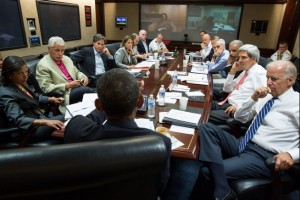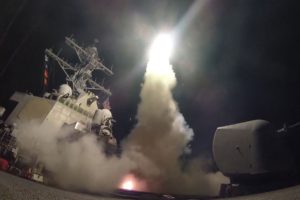Special Report: A new contradiction has emerged in the West’s groupthink blaming Syria for an April 4 chemical attack, with one group of U.N. investigators raising doubt about the flight of a Syrian warplane, reports Robert Parry.
By Robert Parry
The U.S. mainstream media is treating a new United Nations report on the April 4 chemical weapons incident in Khan Sheikhoun as more proof of Syrian government guilt, but that ignores a major contradiction between two groups of U.N. investigators that blows a big hole in the groupthink.
The guided-missile destroyer USS Porter conducts strike operations against a Syrian air base on April 7, 2017. (Navy photo by Petty Officer 3rd Class Ford Williams)
Though both U.N. groups seem determined to blame the Syrian government, the frontline investigators from the Organization for the Prohibition of Chemical Weapons (OPCW) reported that spotters of departing Syrian military aircraft from Shayrat airbase did not send out a warning of any flights until late that morning – while the alleged dropping of a sarin bomb occurred at around dawn.
The report by the U.N.’s Independent International Commission of Inquiry on the Syrian Arab Republic noted that “two individuals interviewed by the OPCW claimed that on the morning of 4 April the early warning system did not issue warnings until 11 to 11:30 a.m., and that no aircraft were observed until that time.”
If the OPCW’s information is correct – that no warplanes took off from the government’s Shayrat airbase until late in the morning – then the Trump administration’s rationale for launching a retaliatory strike of 59 Tomahawk missiles at that airfield on April 6 is destroyed.
But the U.N. commission’s report – released on Wednesday – simply brushes aside the OPCW’s discovery that no warplanes took off at dawn. The report instead relies on witnesses inside jihadist-controlled Khan Sheikhoun who claim to have heard a warning about 20 minutes before a plane arrived at around 6:45 a.m.
Indeed, the report’s account of the alleged attack relies almost exclusively on “eyewitnesses” in the town, which was under the control of Al Qaeda’s Nusra Front and allied jihadist groups.
The report also gives no attention to the possibility that the alleged sarin incident, which reportedly killed scores of people including women and children, was a staged event by Al Qaeda to reverse the Trump administration’s announcement just days earlier that it was no longer U.S. policy to seek “regime change” in Syria.
The Khan Sheikhoun incident prompted President Trump to launch the missile strike that, according to Syrian media reports, killed several soldiers at the base and nine civilians, including four children, in nearby neighborhoods. It also risked inflicting death on Russians stationed at the base.
Lost History
In the U.N. commission’s report, the possibility of a staged event is not considered even though the OPCW had previously uncovered evidence that a chlorine-gas attack in the rebel-controlled town of Al-Tamanah, which also was blamed on the Syrian government, was staged by Al Qaeda operatives and their civilian “relief workers.”

The photograph released by the White House of President Trump meeting with his advisers at his estate in Mar-a-Lago on April 6, 2017, regarding his decision to launch missile strikes against Syria.
OPCW investigators, who like most U.N. bureaucrats have seemed eager to endorse allegations of chlorine-gas attacks by the Syrian government, ran into this obstacle when
townspeople from Al-Tamanah came forward to testify that a supposed attack on the night of April 29-30, 2014, was a fabrication.
“Seven witnesses stated that frequent alerts [about an imminent chlorine weapons attack by the government] had been issued, but in fact no incidents with chemicals took place,” the OPCW report stated. “[T]hey [these witnesses] had come forward to contest the wide-spread false media reports.”
In addition, accounts from people who did allege that there had been a government chemical attack on Al-Tamanah provided suspect evidence, including data from questionable sources, according to the OPCW report, which added:
“Three witnesses, who did not give any description of the incident on 29-30 April 2014, provided material of unknown source. One witness had second-hand knowledge of two of the five incidents in Al-Tamanah, but did not remember the exact dates. Later that witness provided a USB-stick with information of unknown origin, which was saved in separate folders according to the dates of all the five incidents mentioned by the FFM [the U.N.’s Fact-Finding Mission].
“Another witness provided the dates of all five incidents reading it from a piece of paper, but did not provide any testimony on the incident on 29-30 April 2014. The latter also provided a video titled ‘site where second barrel containing toxic chlorine gas was dropped tamanaa 30 April 14’”
Some other “witnesses” who alleged a Syrian government attack offered ridiculous claims about detecting the chlorine-infused “barrel bomb” based on how the device sounded in its descent.
The report said, “The eyewitness, who stated to have been on the roof, said to have heard a helicopter and the ‘very loud’ sound of a falling barrel. Some interviewees had referred to a distinct whistling sound of barrels that contain chlorine as they fall. The witness statement could not be corroborated with any further information.”
Although the report didn’t say so, there was no plausible explanation for someone detecting a chlorine canister in a “barrel bomb” based on its “distinct whistling sound.” The only logical conclusion is that the chlorine attack had been staged by the jihadists and that their supporters then lied to the OPCW investigators to enrage the world against the Assad regime.
The coordination of the propaganda campaign, with “witnesses” armed with data to make their stories more convincing, further suggests a premeditated and organized conspiracy to “sell” the story, not just some random act by a few individuals.
The Ghouta Attack
There was
a similar collapse of the more notorious sarin incident outside Damascus on Aug. 21, 2013, which killed hundreds and was also blamed on the Assad government but now appears to have been carried out as a trick by Al Qaeda operatives to get President Obama to order the U.S. military to devastate the Syrian military and thus help Al Qaeda’s Nusra Front to win the war.

President Barack Obama meets in the Situation Room with his national security advisors to discuss strategy in Syria, Aug. 31, 2013. (Official White House Photo by Pete Souza)
You might have thought that these experiences with staged chemical attacks would have given U.N. investigators more pause when another unlikely incident occurred last April 4 in the town of Khan Sheikhoun, which was under Al Qaeda’s control.
The Trump administration had just announced a U.S. policy reversal, saying that the U.S. goal was no longer “regime change” in Syria but rather to defeat terrorist groups. At the time, Al Qaeda’s Nusra Front, the Islamic State and other jihadist forces were in retreat across much of Syria.
In other words, the Syrian government had little or no reason to provoke U.S. and international outrage by launching a sarin gas attack on a remote town with only marginal strategic significance.
Chemical attacks, especially the alleged use of chlorine but sarin gas as well, also offer minimal military effectiveness if dropped on a town. Chlorine gas in this form rarely kills anyone, and the international outrage over sarin far exceeds any military value.
But the jihadists did have a powerful motive to continue staging chemical attacks as their best argument for derailing international efforts to bring the war to an end, which would have meant defeat for the jihadists and their international allies.
And, we know from the Al-Tamanah case that the jihadists are not above feeding fabricated evidence to U.N. investigators who themselves have
strong career motives to point the finger at the Assad regime and thus please the Western powers.
In the Khan Sheikhoun case, a well-placed source told me shortly after the incident that at least some U.S. intelligence analysts concluded that it was a hastily staged event in reaction to the Trump administration’s renunciation of Syrian “regime change.”
The source said some evidence indicated that a drone from a Saudi-Israeli special-operations base inside Jordan delivered the sarin and that the staging of the attack was completed on the ground by jihadist forces. Initial reports of the attack appeared on social media shortly after dawn on April 4.
The Time Element
Syrian and Russian officials seemed to have been caught off-guard by the events, offering up a possible explanation that the Syrian government’s airstrike aimed at a senior jihadist meeting in Khan Sheikhoun at around noon might have accidentally touched off a chemical chain reaction producing sarin-like gas.

A photo of the crater containing the alleged canister that supposedly disbursed sarin in Khan Sheikdoun, Syria, on April 4, 2017.
But U.S. mainstream media accounts and the new U.N. report cited the time discrepancy – between the dawn attack and the noontime raid – as proof of Russian and Syrian deception. Yet, it made no sense for the Russians and Syrians to lie about the time element since they were admitting to an airstrike and, indeed, matching up the timing would have added to the credibility of their hypothesis.
In other words, if the airstrike had occurred at dawn, there was no motive for the Russians and Syrians not to say so. Instead, the Russian and Syrian response seems to suggest genuine confusion, not a cover-up.
For the U.N. commission to join in this attack line on the timeline further suggests a lack of objectivity, an impression that is bolstered by the rejection of OPCW’s finding that no take-off alert was issued early on the morning of April 4.
Instead, the U.N. commission relied heavily on “eyewitnesses” from the Al Qaeda-controlled town with unnamed individuals even providing the supposed identity of the aircraft, a Syrian government Su-22, and describing the dropping of three conventional bombs and the chemical-weapons device on Khan Sheikhoun around 6:45 a.m.
But there were other holes in the narrative. For instance, in a little-noticed
May 29, 2017 report, Theodore Postol, professor of science, technology and national security policy at the Massachusetts Institute of Technology, challenged the Syria-government-did-it conclusions of The New York Times, Human Rights Watch and the Establishment’s favorite Internet site, Bellingcat. .
Postol’s analysis focused on a New York Times
video report, entitled “How Syria And Russia Spun A Chemical Strike,” which followed Bellingcat research that was derived from social media. Postol concluded that “
NONE of the forensic evidence in the
New York Times video and a follow-on
Times news article supports the conclusions reported by the
New York Times.” [Emphasis in original.]
The basic weakness of the NYT/Bellingcat analysis was a reliance on social media from the Al Qaeda-controlled Khan Sheikhoun and thus a dependence on “evidence” from the jihadists and their “civil defense” collaborators, known as the White Helmets.
Sophisticated Propaganda
The jihadists and their media teams have become very sophisticated in the production of propaganda videos that are distributed through social media and credulously picked up by major Western news outlets. (A Netflix infomercial for
the White Helmets even won an Academy Award earlier this year.)

Panoramic image of the three bomb plumes that an anti-Syrian government photographer claimed to take on April 4, 2017, in Khan Sheikhoun, Syria. MIT analyst Theodore Postol notes that the plumes appear to be blowing to the east, in contradiction of the day’s weather reports.
Postol zeroed in on the Times report’s use of a video taken by anti-government photographer Mohamad Salom Alabd, purporting to show three conventional bombs striking Khan Sheikhoun early in the morning of April 4.
The Times report extrapolated from that video where the bombs would have struck and then accepted that a fourth bomb – not seen in the video – delivered a sarin canister that struck a road and released sarin gas that blew westward into a heavily populated area supposedly killing dozens.
But the Times video analysis – uploaded on April 26 – contained serious forensic problems, Postol said, including showing the wind carrying the smoke from the three bombs in an easterly direction whereas the weather reports from that day – and the presumed direction of the sarin gas – had the wind going to the west.
Indeed, if the wind were blowing toward the east – and if the alleged location of the sarin release was correct – the wind would have carried the sarin away from the nearby populated area and likely would have caused few if any casualties, Postol wrote.
Postol also pointed out that the Times’ location of the three bombing strikes didn’t match up with the supposed damage that the Times claimed to have detected from satellite photos of where the bombs purportedly struck. Rather than buildings being leveled by powerful bombs, the photos showed little or no apparent damage.
The Times also relied on before-and-after satellite photos that had a gap of 44 days, from Feb. 21, 2017, to April 6, 2017, so whatever damage might have occurred couldn’t be tied to whatever might have happened on April 4.
Nor could the hole in the road where the crushed “sarin” canister was found be attributed to an April 4 bombing raid. Al Qaeda jihadists could have excavated the hole the night before as part of a staged provocation. Other images of activists climbing into the supposedly sarin-saturated hole with minimal protective gear should have raised other doubts, Postol noted
in earlier reports.
Critics of the White Helmets have identified the photographer of the airstrike, Mohamad Salom Alabd, as a jihadist who appears to have claimed responsibility for killing a Syrian military officer. But the Times described him in
a companion article to the video report only as “a journalist or activist who lived in the town.”
Another Debunking
In 2013, the work of Postol and his late partner, Richard M. Lloyd, an analyst at the military contractor Tesla Laboratories, debunked claims from the same trio — Bellingcat, the Times and Human Rights Watch — blaming the Syrian government for the sarin-gas attack outside Damascus on Aug. 21, 2013.

Photograph of men in Khan Sheikdoun in Syria, allegedly inside a crater where a sarin-gas bomb landed.
Postol and Lloyd
showed that the rocket carrying the sarin had only a fraction of the range that the trio had assumed in tracing its path back to a government base.
Since the much shorter range placed the likely launch point inside rebel-controlled territory, the incident appeared to have been another false-flag provocation, one that almost led President Obama to launch a major retaliatory strike against the Syrian military.
Although the Times grudgingly
acknowledged the scientific problems with its analysis, it continued to blame the 2013 incident on the Syrian government. Similarly, Official Washington’s “groupthink” still holds that the Syrian government launched that sarin attack and that Obama chickened out on enforcing his “red line” against chemical weapons use.
Obama’s announcement of that “red line,” in effect, created a powerful incentive for Al Qaeda and other jihadists to stage chemical attacks assuming that the atrocities would be blamed on the government and thus draw in the U.S. military on the jihadist side.
Yet, the 2013 “groupthink” of Syrian government guilt survives. After the April 4, 2017 incident, President Trump took some pleasure in mocking Obama’s weakness in contrast to his supposed toughness in quickly launching a “retaliatory” strike on April 6 (Washington time, although April 7 in Syria).
A Dubious Report
Trump’s attack came even before the White House released
a supportive – though unconvincing – intelligence report on April 11. Regarding that report, Postol wrote, “The White House produced a false intelligence report on April 11, 2017 in order to justify an attack on the Syrian airbase at Sheyrat, Syria on April 7, 2017. That attack risked an unintended collision with Russia and a possible breakdown in cooperation between Russia and United States in the war to defeat the Islamic State. The collision also had some potential to escalate into a military conflict with Russia of greater extent and consequence.

President Trump delivers his brief speech to the nation explaining his decision to launch a missile strike against Syria on April 6, 2017. (Screen shot from Whitehouse.gov)
“The New York Times and other mainstream media immediately and without proper review of the evidence adopted the false narrative produced by the White House even though that narrative was totally unjustified based on the forensic evidence. The New York Times used an organization, Bellingcat, for its source of analysis even though Bellingcat has a long history of making false claims based on distorted assertions about forensic evidence that either does not exist, or is absolutely without any evidence of valid sources.”
Postol continued, “This history of New York Times publishing of inaccurate information and then sticking by it when solid science-based forensic evidence disproves the original narrative cannot be explained in terms of simple error. The facts overwhelmingly point to a New York Times management that is unconcerned about the accuracy of its reporting.
“The problems exposed in this particular review of a New York Times analysis of critically important events related to the US national security is not unique to this particular story. This author could easily point to other serious errors in New York Times reporting on important technical issues associated with our national security.
“In these cases, like in this case, the New York Times management has not only allowed the reporting of false information without reviewing the facts for accuracy, but it has repeatedly continued to report the same wrong information in follow-on articles. It may be inappropriate to call this ‘fake news,’ but this loaded term comes perilously close to actually describing what is happening.”
Referring to some of the photographed scenes in Khan Sheikhoun, including a dead goat that appeared to have been dragged into location near the “sarin crater,” Postol called the operation “a rather amateurish attempt to create a false narrative.”
Now, another U.N. agency has joined that narrative, despite a key contradiction from fellow U.N. investigators.
Investigative reporter Robert Parry broke many of the Iran-Contra stories for The Associated Press and Newsweek in the 1980s
River to Sea Uprooted Palestinian
Uprooted Palestinian 














No comments:
Post a Comment